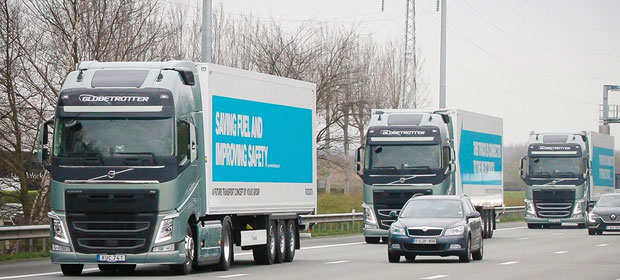It may seem obvious that a major consequence of self-driving trucks would be a lot of unemployed truck drivers, but the reality — at least for those who drive tractor trailers — could be better jobs.
Autonomous vehicles have massive potential benefits. Models suggest that in the U.S. alone, between 30 thousand and 40 thousand lives would be saved annually (for perspective, about 3 thousand died on 9/11). There will be some job losses, and adjustments will need to be made.
I’ll share my thoughts on the job reshuffling while the industry works to stop what has become, thanks to smartphones, a growing cause of premature death in the world.
I’ll close with my product of the week: the Jedi Challenges, a joint offering from Disney and Lenovo I’ve been playing with. Damn thing is a ton of fun.
Truck Drivers Are Safe
Initially, I too thought autonomous vehicles meant truck drivers were toast — but according to the trucking companies, there is so much value in the cargo, they don’t want the trucks going off without drivers. That is smart, given that surveys I’ve seen on this suggest that human drivers are likely to play games with vehicles that aren’t manned.
Someone needs to manage and protect the loads. Otherwise, the fear is that criminals will force the trucks off the road and unload them, or that there will be loading and unloading anomalies that could cost these firms far more than they’d save by not having drivers.
This does mean the driver’s jobs would change, as they would be more like guards and pursers than drivers. However, those are duties most of them have right now, so they’d only lose the driving part of the job — not the job itself. As passengers, they could better keep up with paperwork, and the trucks could stay on the road longer because the drivers could sleep and take breaks while the trucks powered on.
In the end, autonomous-driven trucks could result in higher-quality, lower stress jobs for the drivers, who would be far more able to enjoy entertainment and communicate with friends and family while the trucks did the boring bit.
I understand there are around 50K open driver positions at the moment, so it isn’t like people are flocking to this career. I do expect some companies to run the equivalent of self-driving truck caravans. Breaker, breaker, we have a robotic convoy! However, they would become very attractive targets for thieves and likely require significantly more than one person to manage them and ensure their protection.
I expect bus drivers are relatively safe, too, just to protect against unruly passengers and problems. Again, that is one part of the bus driver’s job that a robot can not easily take over. I imagine that — particularly in a school bus — having the adult on the transport not have to drive and control behavior at the same time would result in not only fewer accidents, but also better-behaved kids.
Trial Attorneys Are Screwed – Sort Of
I mentioned what basically would be a 98 percent-plus reduction in deaths, but the models show this 98 percent-plus reduction would apply to accidents in general. Given the cars record pretty much everything happening around them in high detail and could provide that information in an investigation, fault should be easy to determine.
I expect there will be rules, kind of like the guy-in-the-back rule — you know, the one that says if you are the last car in a pile-up it is your fault. In this case, if there is a human involved, that person will be at fault. That would do some interesting things, as you might imagine, for projected insurance premiums.
For an autonomous car, premiums could drop up to 90 percent. However, given the tolerances with autonomous cars and the expense of the electronics, if a human — I should say when a human — causes an accident, the costs will be astronomical. We could be looking at up to a 10x increase in premiums for human drivers once we get to a critical mass of autonomous cars.
That means we would need about 1/100th the number of trial attorneys, but each of the cases likely would be huge and newsworthy. So, on the down side, a lot of attorneys are going to need to find new areas to specialize in (giving what is going on, I’m thinking sexual harassment and hostile workplace litigation). The ones who remain in vehicle accident litigation will move from being low-fee, low profile and low status to high-fee, high profile, high status. So, I’m not sure that is really bad, even for them.
Medical and Law Enforcement
Car accidents chew up a lot of resources and increase medical costs for all of us substantially, because not everyone is well insured, and hospitals must deal with the injured regardless. A massive reduction in accidents and deaths means we would need a lot fewer EMTs and hospital staff members, because there will be hundreds of thousands fewer people who will need to be treated. (Well, unless these cars go Terminator and then all bets are off.)
Given that these cars tend to err on the side of safety, don’t break laws, and literally can circle forever looking for parking, the need for traffic enforcement should drop like a rock. Given that we also are very short on law enforcement officers, this could result in having officers focus more on non-vehicle related crimes, which should reduce things like robberies and violent crimes in general and provide a strong secondary safety benefit.
Many patrol cars could be fully automated, though, and we already have deployed robotic security guards and thousands of security cameras. Combined, the result should be a vastly higher degree of safety, coupled with a reasonably high expectation that you’ll be on camera much of the time.
As a result, I forecast that tinted windows will be the new must-have option on most autonomous cars — and even homes, going forward. Rather than car chases, the cops likely will be waiting for you at your house if you commit a crime. Police interceptors quickly could become the equivalent of wheeled cruise missiles — or given the capabilities of flying drones, maybe missiles with propellers.
Wrapping Up
The activities of the Teamsters and trial lawyers are largely responsible for preventing the adoption of strong autonomous car legislation, I found out at a recent meeting. The Teamsters — the union protecting drivers — are afraid that self-driving trucks will wipe out their membership. That, at least for distance drivers, is fake news.
The trial lawyers want to be able to have work, which is understandable, but weighing that against the possibility of saving 30-40 thousand lives a year, I doubt they’ll be able to hold out indefinitely. Somehow the tag line “Yes, your mother died, but remember you employed 10 attorneys!” is likely to fall flat in the long term.
I still wonder whether the car companies will survive this change, though. If cars basically become four-wheeled elevators, I just don’t think any but the relatively wealthy will want to own one.
Services like Uber and Lyft (assuming they survive) could give people annual plans like you get for a cellphone, and access to a pool of vehicles for a fraction of the cost of a car. That would allow you to spend more on your spouse, house, hobbies or other things. Certainly, that is what car-sharing services believe will happen, and it looks like Ford and GM are hedging their bets.
I’ll leave you with one other interesting observation. We started working seriously on autonomous cars around 2000, and just about four years ago we started talking about people-carrying drones.
Those drones are going into trials about the same time the cars are, and initial projected deployments are within the same window. Amazon is getting the airspace issues sorted, and companies like Boeing, Airbus, and Uber chasing this, maybe it is time to take the move seriously. Just saying…
The Disney Jedi Challenges Toy by Lenovo is interesting in many ways. One is that it was built by Lenovo to a Disney specification, and I don’t recall any of the other major vendors doing this.
Yes, Disney had PCs, but they were largely ODM-built back then and sucked. The difference between using an ODM (basically a firm that builds to your specification) and an OEM (a company that builds products largely for itself) is that the OEM is far more focused on user experience and less likely, because its name is on it, to let one out that sucks. There was every chance for this thing to suck a lot.
I’ve played with this for a few hours and it doesn’t suck. In fact, it is kind of cool to see a Jedi master appear in your living room and give you instructions on good light saber use. It is also kind of nice that if you accidentally gore your wife with the thing it doesn’t really do any damage. Firing up the light saber and seeing the blade power out of the thing with sound effects is almost worth it alone.

Now the blade doesn’t always completely line up with the light saber, and the light saber feels too light (the reason likely is that if you lose your grip and it goes flying you won’t take out a TV, spouse, sibling, or pet accidentally). It seems to work better in large rooms.
This is an AR (augmented reality) toy that uses your smartphone — mainly LG, Samsung, Motorola, Apple and Google models. The light saber is your pointing device for some of the games and all of the battles I saw. It is a good-looking light saber, and the game play is decent.
Since it is AR and not VR, you don’t trip over furniture or get motion sick, but my wife did think I looked kind of funny hacking away at a robot only I could see.
I got it to work reasonably well with my Essential phone, but you are taking a risk if you have a phone that isn’t on the approved list, which includes the following: iPhone 8 Plus, iPhone 8, iPhone 7 Plus, iPhone 7, iPhone 6s Plus, iPhone 6s, iPhone 6 Plus, iPhone 6; Samsung Galaxy S8, Galaxy S7 edge, Galaxy S7; Google Pixel XL, Pixel; Moto Z2 Force Edition; LG G6.)
If I had built this thing, I would have built the headset into a rebel helmet. Right now, it kind of looks like most VR headsets, in that it really doesn’t look like anything you’d wear in the movie. They missed the cosplay vibe.
It lists for US$374 on Amazon, but Best Buy has it for $200, and at $200 it is a deal. I think Amazon missed a meeting on this one.
Because I’ve been a Star Wars fan since I saw the first movie on opening day, and because I’ve always wanted a light saber that could fire up, the Disney Jedi Challenges toy is my product of the week.

























































Thanks for the great article!